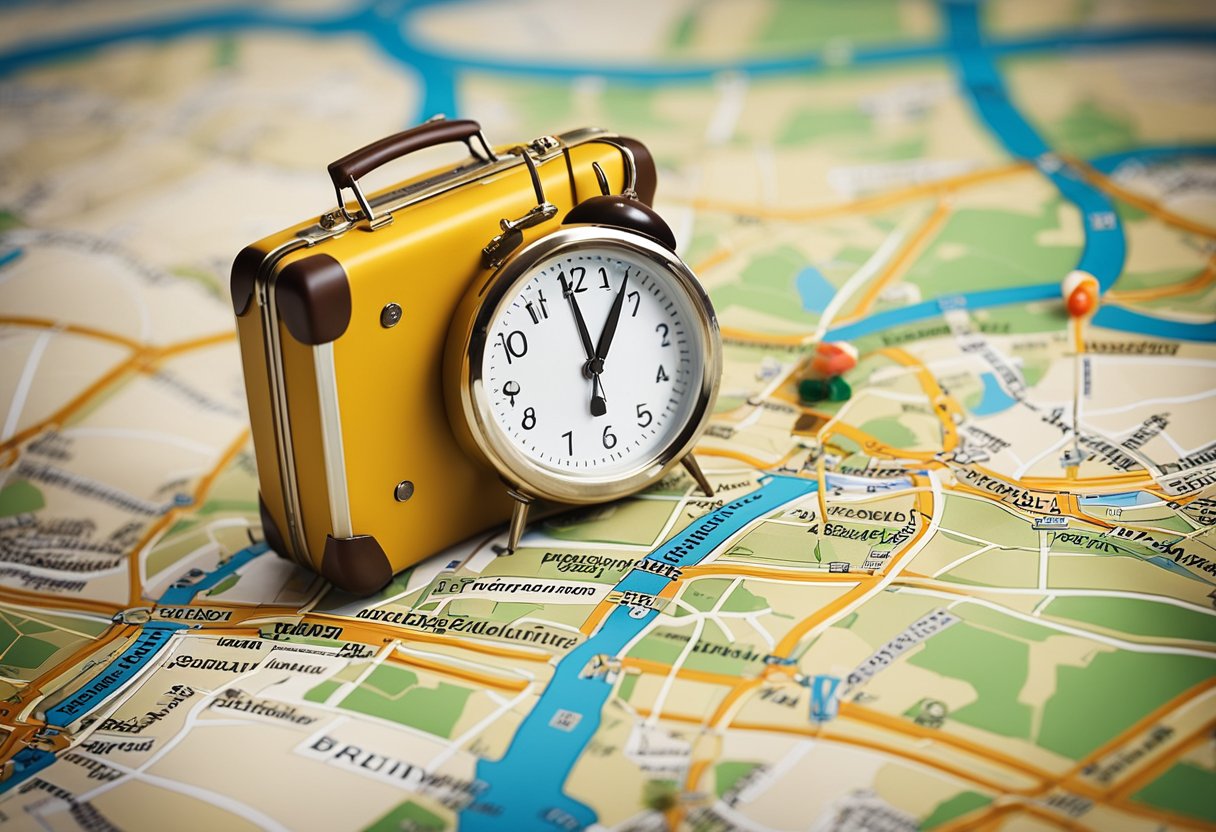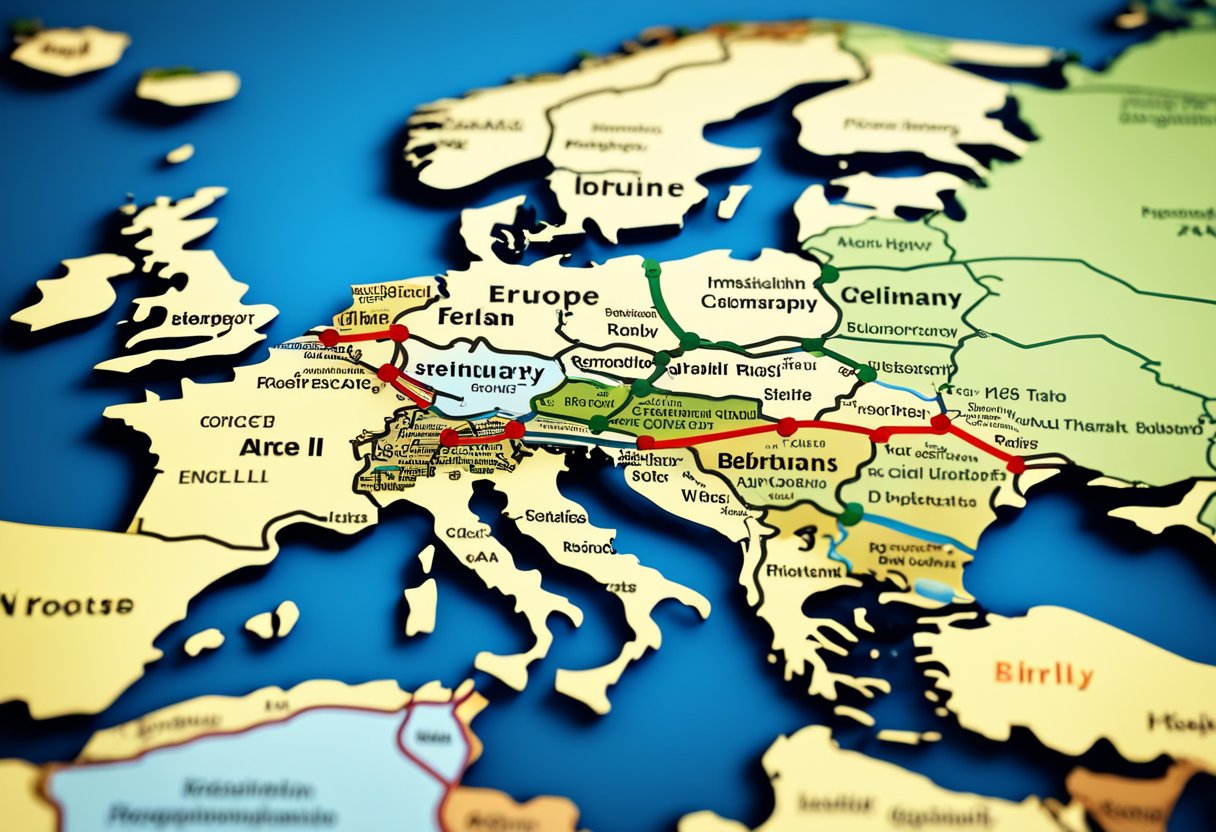Travel duration to Berlin, Germany, a city steeped in history and culture, is a journey that time frames vary depending on the starting point and mode of transportation.
From the United States, a non-stop flight to Berlin Brandenburg Airport, the main international gateway, typically takes around eight to twelve hours.
Upon arrival, visitors can reach the city center via train, bus, or taxi, with transit times generally under an hour.

For those journeying within Europe, Berlin is well-connected by rail and road networks. The train is a popular choice, especially given the efficiency of services like the ICE (Intercity-Express) which provide rapid connections from major German cities; for instance, traveling from Frankfurt to Berlin can take roughly four hours by high-speed train.
Bus travel offers a more economical but slower alternative, while renting a car affords flexibility and the drive from Frankfurt can take about six hours under ideal traffic conditions.
Berlin’s comprehensive transportation infrastructure and its position as a hub in Germany’s and Europe’s transport networks make it an accessible destination for travelers.
A travel guide to Berlin would recommend examining all the possible travel options to ensure the journey is as efficient as possible, whether the trip is for business, pleasure, or an explorative adventure into one of Europe’s most vibrant capitals.
Planning Your Trip to Berlin

Planning a trip to Berlin requires considering the optimal travel period and understanding the city’s geographical positioning and distance from your starting location.
Travel duration to Berlin
When considering a trip to Berlin, one important aspect is determining the best time to visit. Berlin’s climate is typically continental, with cold winters and warm summers.
The most favorable months for traveling are from May to September, where one can enjoy a range of festivals and outdoor activities. Additionally, flight prices can fluctuate, so using flight comparison tools can ensure a cost-effective journey.
Understanding the Geography and Distance
Berlin is situated in northeastern Germany and serves as an important European hub for travel. Berlin Brandenburg Airport (BER) is the main international airport, with excellent connections to the city center.
When traveling from within Europe, such as from Frankfurt, the distance to Berlin is roughly 550 km (340 miles), and by high-speed train, the journey can take around four hours. For those considering driving, it’s essential to account for possible congestion, especially during peak travel seasons.
Choosing Your Mode of Transportation

When planning a trip to Berlin, Germany, travelers should consider the distance, cost, and travel time associated with different modes of transport. Each method offers its own balance of comfort, speed, and affordability.
Traveling by Plane
Flights to Berlin often land at the Berlin Brandenburg Airport (BER), where passengers can then take various forms of transport into the city. Major airlines such as Lufthansa, Swiss, KLM, and low-cost options like Ryanair provide services to BER.
The flight duration varies — from nearby European cities like Frankfurt, flights may take just over an hour, while intercontinental trips can last upwards of ten hours. From the airport to the city center, travelers can utilize the Airport Express and Regional Express trains, which can take about 30 minutes.
Traveling by Car
Driving to Berlin from surrounding cities or countries can be a practical choice for those who prefer greater flexibility.
The time it takes to drive to Berlin varies significantly; for example, the distance from Frankfurt to Berlin is about 540 kilometers, which could take roughly five to six hours, depending on traffic conditions. Car rental services and car-sharing options are available for those who do not own a vehicle.
Traveling by Train
Deutsche Bahn operates an extensive network of high-speed ICE trains, Intercity trains, and regional services. Train travel offers a convenient, reliable way to reach Berlin from different German cities or neighboring European countries.
For instance, connections from Frankfurt can take approximately four hours on the ICE. Train services also link to international routes, including the Eurostar from London and Thalys from Paris, allowing for smooth travel across the continent to Berlin.
Traveling by Bus
For budget-conscious travelers, buses provide an affordable option. Companies like Flixbus offer regular services to Berlin from various locations within Germany and beyond.
While bus journeys can take longer compared to flights or trains — sometimes exceeding eight hours on longer routes — the cost savings could be significant for those willing to travel more slowly.
Booking and Ticketing Information

When planning a trip to Berlin, Germany, efficient booking and finding the best ticket prices are crucial. There are numerous platforms and services that facilitate these processes, catering to various preferences and budgets.
Finding the Best Ticket Prices
Ticket prices can vary greatly depending on the mode of travel, time of booking, and current promotions. To secure affordable fares:
- Compare prices: Utilize tools like Rome2rio or Omio to compare ticket costs across multiple forms of transportation.
- Book in advance: Prices for flights, trains, and buses tend to increase closer to the departure date.
For trains within Germany, such as a journey from Frankfurt to Berlin, it’s beneficial to book directly through the Deutsche Bahn’s website. Their offerings include various deals, such as the Deutschland Ticket, which offers nationwide travel for a fixed monthly price.
Using Travel Booking Platforms
Platforms like Omio and Rome2rio not only help compare prices but also provide a concise booking experience:
- Omio: Allows travelers to buy tickets directly for trains, buses, and flights in one interface.
- Rome2rio: Displays different routes to Berlin, including estimated durations and distances, such as the 600 km (approximately) from Frankfurt to Berlin and options for travel from Berlin Brandenburg Airport to the city center.
Using these platforms can significantly streamline the booking process, ensuring travelers find the best options tailored to their schedules and budget needs while providing a clear understanding of the travel time and distance involved.
Accommodation and Local Transportation

When planning a visit to Berlin, securing suitable accommodation and understanding the public transportation system are critical. Berlin offers a variety of lodging options to fit different budgets and preferences, and the city’s extensive transit network enables convenient travel to and from key locations like Berlin Hauptbahnhof and Berlin Brandenburg Airport.
Finding Accommodation in Berlin
Accommodation in Berlin caters to a wide range of preferences, from luxury hotels to budget-friendly hostels. Travelers can commonly find a comfortable place to stay for around $140 (€128) per night for hotels or considerably less for hostels.
A recommendation for visitors looking to explore the city is staying within the central districts like Mitte or Kreuzberg, which offer easier access to public transport and local attractions.
Navigating Public Transportation
Berlin’s public transportation is efficient and can be the most cost-effective way to travel around the city. A single one-way ticket on buses and trains costs around $3 (€2.70).
Travelers can reach Berlin Hauptbahnhof, the city’s main railway station, from various corners of Berlin using the S-Bahn, U-Bahn, trams, or buses, with the average travel time approximately 30 minutes from central areas.
Likewise, the journey from Berlin Brandenburg Airport to the city center is straightforward, usually taking less than an hour and costing about $3 (€2.80) by public transport.
Traveling Within Germany and Nearby Countries

When visitors reach Berlin, they often discover that Germany’s efficient transport network and its proximity to other European countries offer a wealth of travel opportunities. Whether they’re looking to explore bustling cityscapes or venture across borders, the options abound.
Exploring Connections to Other Cities
Germany boasts an extensive rail network, making travel between major cities both convenient and quick. The high-speed ICE (InterCity Express) trains connect Berlin with key destinations like Munich (approximately 4 hours), Frankfurt (around 4 hours), Hamburg (about 1.5 hours), and Cologne (roughly 4.5 hours).
Regional trains offer access to scenic routes along the Rhine, through vineyards, and into the enchanting Black Forest. Travelers can experience the historical charm of Dresden (2 hours), the vibrant culture of Düsseldorf (4.5 hours), and the innovative spirit of Stuttgart (6 hours) with relative ease.
For those wishing to explore city environments with unique personalities, Leipzig and Nuremberg are just about 1 to 2 hours away. Moreover, the maritime atmosphere of the North Sea and Baltic Sea can be reached within a few hours, creating a perfect getaway.
Cross-Border Travel Options
Germany is also a gateway to other European countries such as Denmark, France, Austria, Netherlands, Belgium, and Poland.
With Berlin as a starting point, a trip to Warsaw, Poland, can take roughly 6 hours, while the historic city of Aachen, near the borders of Belgium and the Netherlands, is accessible within 6 hours. Copenhagen, Denmark, can be reached in about 7 hours, and the same duration applies to Vienna, Austria.
Travelers can cross the French border to Strasbourg from cities like Karlsruhe or Stuttgart, and continue on to experience the allure of Paris within a total of approximately 8 hours from Berlin.
The train journey to Amsterdam, Netherlands, takes about 6 hours, allowing visitors to experience a seamless transition from the architectural heritage of Germany to the iconic canals of the Netherlands.
Additional Travel Considerations
When planning a trip to Berlin, Germany, travelers should consider not only the duration of the flight but also additional aspects that might affect their travel experience, including language, logistics, and dietary concerns.
Cultural Insights and Language
Understanding the local culture and language can greatly enhance the experience in Berlin. German is the official language, and while English is widely spoken in tourist areas and major cities, learning basic German phrases can be helpful for navigating more local areas or in appreciating historical sites, such as the Berlin Wall.
Tourists should be aware of German customs and social norms to interact pleasantly with the locals.
Dealing with Luggage and Bikes
Travelers flying into Berlin Brandenburg Airport will find efficient transport options to the city center, but they need to manage their luggage efficiently.
It’s recommended to use luggage with wheels due to the distances that may be involved within the airport and public transport stations.
For those planning to explore Berlin by bike, which is a popular mode of transport given the city’s focus on nature and sustainability, there are bike rental services available, and some public transport allows bikes during off-peak hours.
Dining and Special Dietary Needs
Berlin is a haven for diverse culinary preferences, and most restaurants offer a variety of international cuisines. Vegetarians and those with special dietary needs will find plenty of options.
It’s important to communicate any dietary restrictions clearly; although many restaurants have English menus, not all staff may be fluent in English. From traditional German dishes to international fare, there’s something to suit all palettes.
Seasonal and Budget Travel Tips
When planning a trip to Berlin, Germany, consideration of travel costs and the ideal season for visiting can ensure an enjoyable experience. Timing one’s visit can affect both the budget and the duration of travel.
Traveling on a Budget
For those seeking the cheapest way to travel, it is worth noting that Berlin’s accommodation options are quite varied. Hostel prices range from 17-25 EUR per night for dorms, while private rooms can cost approximately 45-56 EUR per night. Consider visiting during off-peak seasons to find the cheapest prices.
Regarding transportation, Berlin’s efficient public transport system includes options like a single ticket for just €2.90 or a one-day ticket for €8.60. For longer stays, a 7-day pass costs around €34.
It typically takes a person flying from Frankfurt to Berlin Brandenburg Airport about an hour, making it a speedy and cost-effective choice for domestic travelers.
International travelers might find longer transit times, but the convenience of Berlin Brandenburg Airport being relatively close to the city center minimizes additional travel time once they land in Berlin.
Best Times to Visit Berlin
The best times to visit Berlin are generally during spring and autumn when the weather is pleasant and the tourist crowds are smaller. Summer in Berlin can be vibrant and full of outdoor events, but it’s also when the city sees the most visitors, so plan accordingly. A person seeking milder weather and fewer tourists would benefit from visiting in May or September.
For the budget-conscious traveler, winter outside of the holiday season can provide significant savings on accommodations and attractions, though one should be prepared for colder temperatures. When planning the length of a visit, travelers should account for seasonal variations which may impact their itinerary and the time required to see the city’s highlights.
Creating a Comprehensive Itinerary
When planning a trip to Berlin, Germany, one must first determine the duration of travel to the city. The time it takes to get to Berlin varies greatly depending on the starting location and mode of transportation.
For instance, flying into Berlin Brandenburg Airport directly often proves to be the most efficient method for international travelers, with flights from major European cities like Frankfurt taking approximately one hour.
Upon arrival at Berlin Brandenburg Airport, they can reach the city center in about 30 to 60 minutes through various options such as trains, buses, or taxis.
| Mode of Transportation | Time to City Center |
|---|---|
| Train (Airport Express) | ~30 minutes |
| Bus | ~45 minutes |
| Taxi | ~50 minutes |
For travelers within Germany, driving or taking a train to Berlin can be practical. The distance from Frankfurt to Berlin is roughly 550 kilometers, translating into a driving time of around five to six hours, traffic depending. Train journeys can be shorter, especially if one opts for the high-speed ICE services.
An itinerary should account for these travel times, allowing for flexibility due to potential delays. It’s recommended to plan for at least three full days to explore Berlin, given its rich historical landscape and modern attractions.
- Day 1: Focus on historical sites like the Brandenburg Gate and the Holocaust Memorial.
- Day 2: Diversify with a mix of museums and leisurely strolls through Berlin’s eclectic neighborhoods.
- Day 3: Add a day trip or continue exploring more nuanced attractions within the city.
By combining efficient travel planning with a realistic assessment of the time required to appreciate Berlin’s offerings, individuals can create a comprehensive itinerary that maximizes their visit to this captivating city.
Frequently Asked Questions
When planning a trip to Berlin, potential travelers often inquire about travel durations and logistical details. These questions range from specifics about flight times to the recommended duration of a visit.
What is the duration of a direct flight from New York to Berlin?
The duration of a direct flight from New York to Berlin typically ranges from 7 to 8 hours.
How much time does train travel take from major European cities to Berlin?
Train travel times vary, from about 1.5 hours from Hamburg, about 4.5 hours from Amsterdam or Prague, and roughly 6 hours from Vienna to reach Berlin.
Is there a time difference in flight duration from various US cities to Germany?
Yes, flight durations from U.S. cities to Germany differ significantly. For instance, direct flights from Los Angeles can take around 11 hours, while flights from Chicago are approximately 8 hours long.
What options are available for direct flights to Berlin from within the United States?
Several major U.S. cities offer direct flights to Berlin, including New York, which has flights to Berlin Brandenburg Airport.
What is the approximate flying distance from the USA to Germany?
The approximate flying distance from the USA to Germany ranges from about 4,000 miles (e.g., New York to Frankfurt) to over 6,000 miles (e.g., San Francisco to Frankfurt).
What is a recommended length of stay for a tourist visiting Berlin?
A recommended length of stay for tourists visiting Berlin is usually around 3 to 5 days to cover the city’s key historical and cultural attractions.